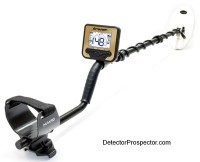
Introducing the Makro Gold Kruzer metal detector, new for 2018. The Makro Gold Kruzer is available now from select dealers. The 61 kHz Gold Kruzer breaks new ground by being the lightest weight highest frequency waterproof detector on the market. Be sure and read the detailed review by Steve Herschbach at the bottom of this page below the specifications list.
The Makro Gold Kruzer comes standard with a 10" x 5.5" concentric coil plus a 4" x 7.5" DD coil and has one optional coil available at launch. The Gold Kruzer has proprietary 2.4 Ghz wireless headphones included. The big announcement of note however is the very high 61 kHz operating frequency, making this one of the hottest machines available on tiny non-ferrous targets, and the only one waterproof to over 5 meters (16.4 feet).
There are already a number of detectors on the market operating in the over 40 kHz region and the basics of this high frequency detection have been covered well for at least twenty years. In other words, if all a person wants is a detector running in a high frequency threshold based all metal mode, there are quite a few options to choose from.
What makes the Gold Kruzer interesting is that as far as I can recall, nobody has made a detector before where the primary design intent is jewelry detecting. More to the point with the Gold Kruzer - detecting for micro jewelry. Micro jewelry has no exact definition but basically just means very small, hard to detect jewelry. Things like thin gold chains, or single post earrings. Most standard coin type detectors are weak on these sorts of small targets, if they can even detect them at all. Up until now people had to choose between coin detectors that have the features but are weak on micro jewelry targets, or use dedicated gold prospecting detectors hot on small targets, but very limited in features. What that usually means is little or no discrimination features.
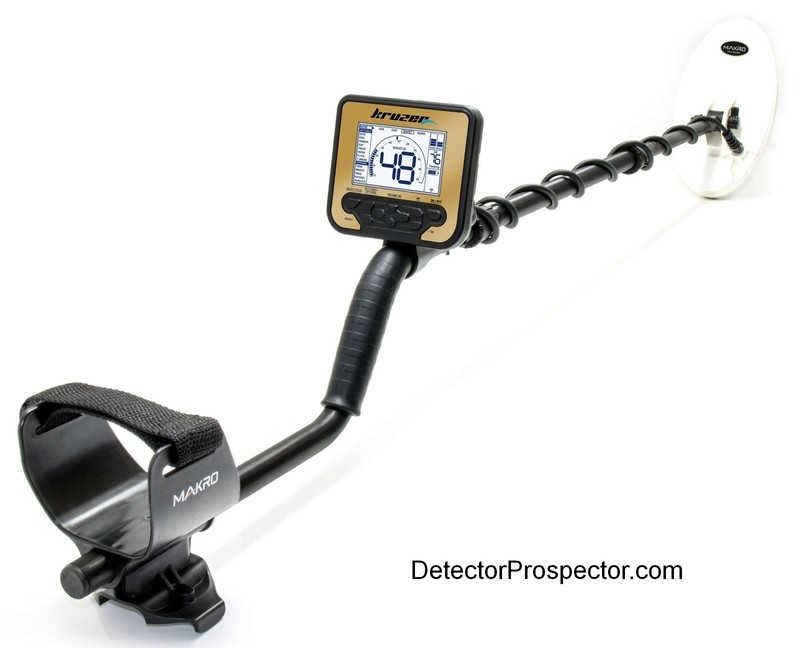
Makro Gold Kruzer for detecting jewelry, gold nuggets, and more
Makro has gained attention as a company that listens to its customers. The new Gold Kruzer model is the perfect example of that, creating a unique machine based almost solely on feedback provided by customers in the last couple years. The Micro Mode on the new Gold Kruzer is a direct nod to those who want a detector for hunting micro jewelry and possibly even for gold prospecting, but who do not wish to give up the features available on most detectors today. In fact, Makro goes a step beyond, with the Gold Kruzer sporting features not included on many detectors today. These would include being waterproof to ten feet of more (16.4 feet with the Gold Kruzer), built in wireless headphone capability, and the ability to receive firmware updates via the internet.
The result is a new detector with a unique feature set. There is literally no other detector made right now operating over 40 kHz that is fully submersible. Built in wireless and internet updates are frosting on the cake.
Official Makro Gold Kruzer Page
Makro Gold Kruzer Full Color Brochure
Makro Gold Kruzer Instruction Manual
Forum Threads Tagged "makro kruzer"
| Internet Price | $636 |
| Technology | Induction Balance (IB) |
| Frequency | 61 kHz |
| Autotune Mode(s) | iSAT Intelligent Self Adjusting Threshold |
| Ground Rejection | Grab, Manual, & Tracking |
| Soil Adjust | Yes |
| Discrimination | Visual ID & Tone ID, Tone Break Adjustment |
| Volume Control | Yes |
| Threshold Control | Yes |
| Tone Adjust | Yes |
| Audio Boost | Yes |
| Frequency Offset | Yes |
| Pinpoint Mode | Yes |
| Audio Output | Speaker & Waterproof Headphone Socket |
| Hip Mount | Shaft Mount Only |
| Standard Coil(s) | 10" x 5.5" Concentric & 4" x 7.5" DD |
| Optional Search Coils | Yes |
| Battery | LiPo Rechargeable (optional external AA pack available) |
| Operating Time | Up to 19 hours |
| Weight | 3.0 pounds |
| Additional Technology | iMask noise suppression technology, backlit screen, save settings |
| Notes | Includes 2.4 Ghz wireless headphones, waterproof to 5 meters (16.4 feet) |
*Notes on Technical Specifications - Detailed notes about the specifications listed in this chart.
Detailed Review Of Makro Gold Kruzer by Steve Herschbach
I was asked to review a new gold detector in the fall of 2014 from a company I had never heard of before then – the FORS Gold by the Nokta company based in Istanbul, Turkey. I was pleasantly surprised to find the Nokta FORS Gold to be a very capable 15 kHz VLF detector that could serve well not just for nugget detecting, but almost any detecting tasks.
The FORS Gold did have some odd design quirks, like the use of mechanical rocker switches instead of touch pads. I listed a few of these things, expecting that would just be the way it is. I was almost shocked when within a short period of time Nokta fixed or changed every item I had mentioned in my review as possibly needing improvement. This was unusual as normally once a machine has gone into production manufacturers are extremely resistant to design changes, especially changes in the physical design. It was a sign of what people have now found to be fact – that this company is serious about listening to their customers as a prime driver for product improvement.
It was revealed that Nokta had a sister company called Makro, and the two officially combined forces shortly after I made my review. In other words, both Nokta and Makro now share the same ownership and management, but continue to be marketed separately under the two brand names. The detector models that each sell are unique, but there is an obvious sharing of the underlying technology between some models that the two brands sell.
I had commented at the time that I would prefer a more standard configuration for a LCD based detector rather than the non-standard configuration as presented by the FORS Gold. By the fall of 2015 I was using the new Makro Gold Racer, which incorporated many ideas I had lobbied for over the years with detector manufacturers. I had been trying for some time to get somebody to create a metal detector that ran at nugget detecting type frequencies over 30 kHz but with a full target id system. It seems strange now but at that time nobody made such a detector.
The Makro Gold Racer was quite unique in 2015 by offering a detector running at 56 kHz that also offered a full range LCD based target id system and dual tone based audio discrimination modes. This made it a detector useful not just for nugget detecting, but low conductor hunting in general for relics and jewelry. It is even a halfway decent coin detector for regular park type scenarios. The versatility and well thought out control scheme scored points with me, and I still have the Makro Gold Racer even after selling most of my other detectors.
It seems that the moment the Makro Gold Racer hit the streets, that everyone else was working on similar ideas, as other detectors running over 30 kHz but with a full feature set started to appear on the market. High frequency detecting is suddenly in vogue for more than just gold nugget detecting.
The one thing obvious now about the Makro / Nokta partnership is that they never sit still, but continue to work on and release new models at a pace that puts all the other manufacturers to shame. The companies are also big believers in seeking public feedback and then implementing the suggestions to create better products for their customers. This is readily apparent in the progression I have personally witnessed in going from that original Nokta FORS Gold to the new 61 kHz Makro Gold Kruzer just now hitting the market. In less than four years the company has gone from “catching up” to meeting or surpassing detectors made by other companies.
ads by Amazon...
The Makro Gold Kruzer has a full suite of functions, is fully waterproof, incorporates built in wireless headphone capability, and can be firmware updated over the internet. That short feature list alone puts the Makro Gold Racer in a very select group of detectors offering those same 21st century “basic features” that were lacking in almost all detectors made in the last century.
The Makro Gold Kruzer obviously builds on the Gold Racer feature set with the following key differences. The Gold Racer runs at 56 kHz and the Gold Kruzer at 61 kHz, one of the highest frequencies available in consumer metal detectors. This continues the focus on detecting small low conductor targets. The Gold Kruzer is waterproof to 5 meters (16.4 feet) whereas the Gold Racer is not waterproof at all. Finally, the Gold Kruzer adds a three tone hunt mode, taking things up another step from the dual tone modes available on the Gold Racer.
Now let’s look at the Makro Gold Kruzer in detail. Makro switched things up in that the Gold Kruzer comes with two coils, a 5.5” x 10” concentric coil, and a 4” x 7.5” DD coil; both include scuff covers. The 5.5” x 10” concentric coil, which was an option offered for the Gold Racer, has been redesigned and cut from 1” thick to ¾” thick and the weight reduced to 384 grams (13.5 oz). The coil is hollow and therefore slightly buoyant, so the 25% reduction in thickness is quite welcome in reducing that buoyancy to where it is basically unnoticeable underwater.
The little 4” x 7.5” DD coil is a solid epoxy filled coil which works extremely well in smaller coils where epoxy filling does not result in too much weight. The small DD coil weighs 368 grams or 13.0 oz. There is one accessory coil available at this time, a 5” x 9.5” epoxy filled DD. This coil weighs 14.3 oz or 404 grams. It should be noted that because of the frequency change and with the Gold Kruzer using waterproof connectors, that Makro Gold Racer coils will not work on the Gold Kruzer.
Makro has also learned lessons as regards coil ear durability. The coil ears on the Gold Kruzer are about twice the mass of those on my older Makro Gold Racer. Taller, wider, and thicker – these extra beefy coil ears should all but eliminate breakage issues.
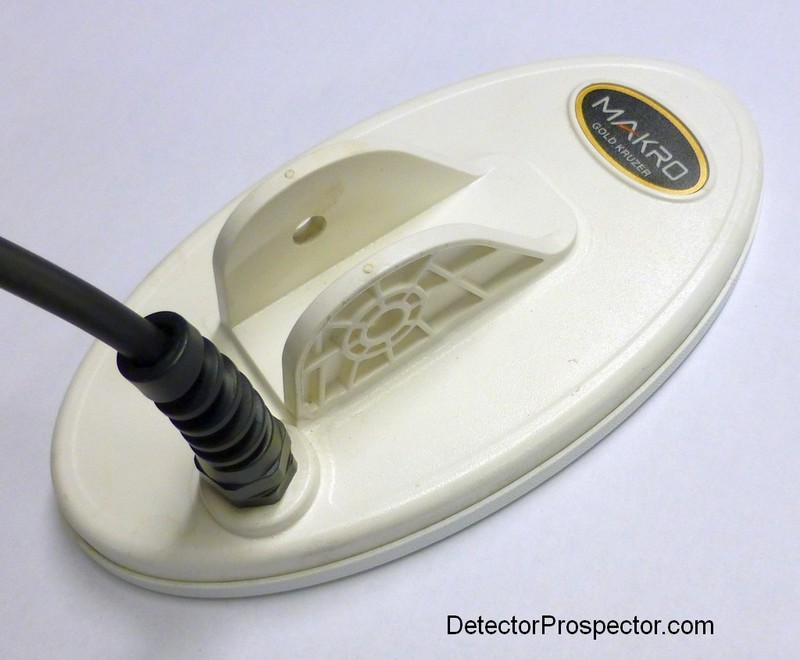
4” x 7.5” DD coil showing beefed up ears
The Makro Gold Kruzer employs a fairly standard “detector pod on an S rod” design forgoing the underarm battery box used on the Gold Racer. This confers a large advantage when it comes to waterproofing the detector in that only the pod has to be sealed. The change from AA batteries to a built in sealed LiPO rechargeable battery also aids in eliminating battery doors, which are always at risk of leaking.
The three piece S rod itself is quite stout with no flex or wiggle. The cross hatch carbon fiber lower rod is not only strong, but lends an air of high tech quality to the look of the detector. The Gold Kruzer does not have the separate underarm battery compartment and in handle vibration mechanism featured on the Makro Gold Racer. This means the pod is totally self contained and can be removed from the handle assembly. This in turn allows for other rod options and the ability to break the detector completely down fitting in a small backpack or carry on bag.
When the stout rod is combined with the beefed up coil construction you have a design that should survive those spills a person can take when working in the surf and there the detector ends up acting like a walking stick for support.
It has been interesting to watch the company experiment with different handle designs. It is a thankless task because you never can please everyone. For me at least the handle / rod may be the best yet from Makro, with a molded hard rubber grip that will serve very well for a detector that may see underwater use. I personally found the Nokta Impact handle to be large for my hands and the smaller Gold Kruzer handle near perfect. Others may feel just the opposite so there you go.
The arm cuff is a little different. It is narrower than some – good for me but maybe not so much for somebody with huge forearms. The adjustment is non-standard, with the arm cup sliding up and down the upper rod over a set of threaded holes. A small screw inserted into the top of the armrest and into one of these threaded holes secures the armrest in place.
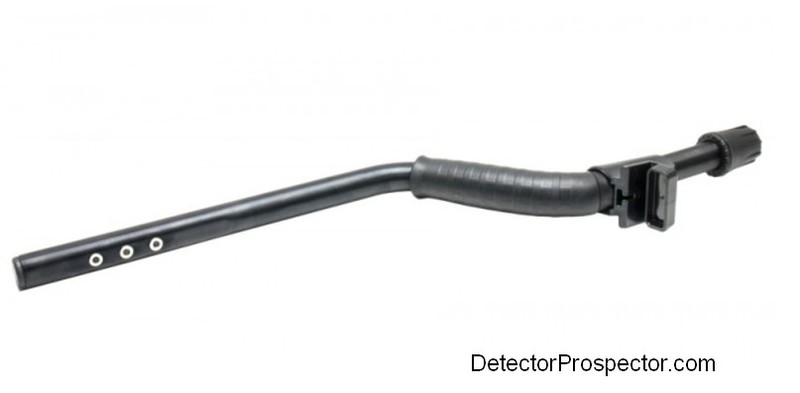
Kruzer upper rod showing cuff adjust holes and hand grip (control box removed)
A unique feature on the Gold Kruzer is an optional external AA battery pack that can provide extra operating time in the field should the internal rechargeable battery go dead. The pack is designed to be held into the bottom of the detector armrest / stand by a separate plastic cover bracket that is held in place with two screws. I found the holes these screws go into will fill with sand if this bracket is left off, so I advise installing the bracket even if the external battery pack is not in use. The external battery pack with bracket is an option and so dummy screws or plugs should be installed to keep the screw holes clean and free of debris by those who down not have the bracket.
I don’t think most people will ever need the external battery pack as long as the detector is regularly charged after use. It is a very nice touch however, especially for off grid use, as all you need is the external AA battery pack and a box of AA batteries to off grid for as long as the batteries will last. Some people may want the optional battery pack for travel into the field just in case the battery runs short on power in the middle of a hunt.
The port where you attach the external battery pack also acts as a port to attach a USB style charger cable. The detector is charged using this cable by employing the included USB wall charger. You may also use most USB charging adapters and newer computer USB ports.
The USB cable also allows the Makro Gold Kruzer to be attached to a computer so that updates can be made in case any bugs are found in the future. This update feature is very nice insurance that should be standard on all new detectors.
Another item that should be standard on all new detectors is built in wireless headphone capability. Makro uses a proprietary low latency system that exhibits no discernible lag at all. A really nice thing about being proprietary is there is no pairing process. All you have to do is enable the wireless feature on the control box, turn on the headphones, and boom, you are in business. The downside is you only have one choice of headphones – the included Makro wireless headphones. These are a nice, light set of phones but they are just a bit too small to fit over most people ears. I have fairly small ears and they still rest on instead of over my ear. The sound quality is good, but like most wireless headphones they seem less “bright” than wired headphones. All in all the wireless headphones are quite good however and a pleasure to use.
The Makro Gold Kruzer does have a waterproof speaker with decent volume that can be used instead of the wireless headphones. If you prefer other headphone options, be sure and get the optional waterproof port to ¼” headphone adapter cable. This cable attaches to the same port used for charging and software updates and allows any wired headphones to be adapted to the Gold Kruzer.
The LCD display is well laid out with a very large target id number displayed. The other setting indicators might be a little harder for those with poor eyesight to make out, but should present no issues once the layout is learned. One big change from the Gold Racer is that the four large navigation buttons, trigger switch, and rotary dial power / volume switch have all been replaced by ten small buttons on the control panel. All the buttons can be reached and controlled by the operators thumb, but the small size and closeness of the buttons may make for some navigation errors early on, and especially when trying to change settings underwater or with gloves on.
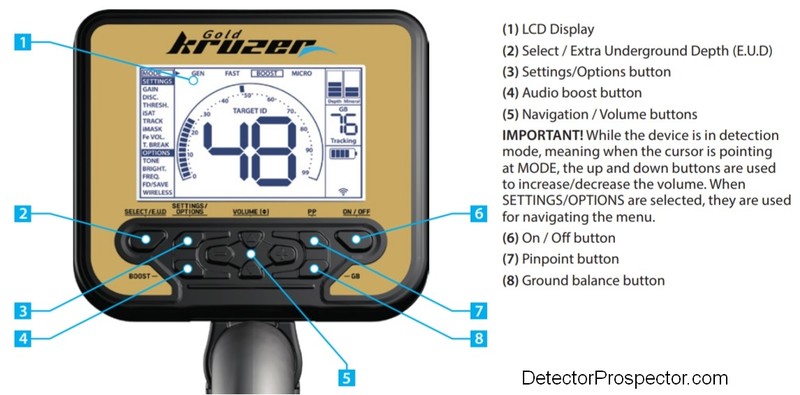
Makro Gold Kruzer display and controls
The Makro Gold Kruzer User Manual is available for download so I will refer you there for all the little details. What you have in the Makro Gold Kruzer is a hot 61 kHz metal detector waterproof to 5 meters (16.4 feet). The Gen (General) mode is a fairly standard VCO audio all metal gold nugget detecting circuit. The Gold Kruzer in Gen mode is very reminiscent of other hot gold nugget detectors running in the all metal prospecting mode.
The Gen mode acts exactly like one would expect a threshold based all metal mode to function. There is a nice smooth threshold that gives feedback about the ground and reacts to hot rocks with classic nulling signals and small nuggets with that classic “zip-zip” VCO audio. Voltage Controlled Oscillator (VCO) audio increases both in volume and pitch when a target is detected, giving a distinct response very common on many gold detectors. The only thing different here is that since the Gold Kruzer has an LCD readout; you can get target id number results while running in all metal Gen mode. The audio is far more sensitive than the meter however, so do not be surprised if the deepest and smallest of targets give no target id information.
In a break with the Gold Racer the Fast and Boost modes are not dual tone modes, but instead are silent search (no threshold) single tone modes. Items either signal audibly or not based on the current discrimination settings. The discrimination setting, like that of the Gold Racer, is a simple up and down control. Everything above the setting gives an audio signal of “beep”. Anything below the discrimination setting level is rejected or ignored with no sound at all. The Gold Kruzer has no notching capability i.e. the ability to pick and choose individual target id numbers for rejection.
Fast mode is just what it sounds like – a fast setting for working in really dense trash. Target recovery speed has been increased at the expense of outright depth, but sheer depth is useless where target masking is the main problem. Boost mode is exactly the opposite. Boost is the deepest discrimination mode on the Gold Kruzer but due to the increased sensitivity is more suitable for less mineralized ground and sparser targets.
ads by Amazon...
It should be obvious that the Makro Gold Kruzer is all about gold. This explains the shift from dual tone to monotone audio in the Fast and Boost. Dual tones as employed in the Makro Gold Kruzer can be problematic when hunting the smallest gold targets, especially in highly mineralized ground. It is hard for a detector to get a clean separation of ferrous and non-ferrous targets when the targets are very small.
This is because the actual dividing line between ferrous and non-ferrous is not a line at all, but a zone. The Makro Gold Kruzer uses a fairly standard discrimination scale that ranges from 0 – 99. The range from 0 – 40 is considered to be the ferrous range, and 41 and above non-ferrous.
Yet the discrimination default for both the Fast and Boost modes is 25. This is because if you bury small gold in highly mineralized ground or large gold extra deep in mineralized ground, the ferrous ground signal can overwhelm the very weak non-ferrous signal. It really is not about the object size. A deep large nugget is a very weak signal just the same as a shallower small nugget, and either can end up reading as a ferrous target.
The solution is to lower the discrimination setting into the ferrous range and accept that you have to dig some ferrous items to get all the gold items. This actually applies to any metal detecting. If you dig absolutely no ferrous trash, you are almost 100% guaranteed to be passing up some non-ferrous items reading incorrectly as ferrous. This can be acceptable of course depending on what you are doing, but passing on a deep six ounce gold nugget because it reads ferrous can be an expensive mistake. The Gold Kruzer default discrimination setting for Fast and Boost is 25 instead of 40 for this very reason.
Dual tones have issues for this same reason, with decisive results on the weakest targets difficult if not impossible to obtain. The difference is quite small, but monotone is slightly more stable and proficient at working with the tiniest and faintest of signals right at the dividing line between ferrous and non-ferrous, wherever you have set the control to tell the Gold Kruzer where that line is for your particular situation. There is no pat answer as the where to set the discrimination control. It is a judgment call based on experience, but when in doubt, use less discrimination and dig more trash. Welcome to gold detecting!

Makro chart showing gold occurring in 0 – 40 ferrous range
The Makro Gold Kruzer has a new control that relates to this overlap between ferrous and non-ferrous readings. The Extra Underground Depth (E.U.D.) control acts to directly impact the tipping point between ferrous and non-ferrous readings. The E.U.D. control only works in one of the three discrimination modes and when used on a suspect target that is reading ferrous may reveal by a different tone that it is actually non-ferrous. It is noted in the manual that it can reveal some targets misidentified as ferrous, but it will also give more false positives on ferrous targets.
I was unable in the time allowed to figure out just how efficient this control is. In theory you can just set the discrimination lower, digging more ferrous but getting those missed non-ferrous items. Or set the discrimination a little higher, and now examine suspect targets individually by engaging the E.U.D. control momentarily. Finally, you can run E.U.D. on at all times. Is higher disc with E.U.D. on at all times going to get better results than just using a lower discrimination setting? Sadly, I just do not know at this time. I do know it is no magic bullet so the efficiency of employing the E.U.D. control will have to be determined over time by users around the world
What? You say you wanted tones? Well, the Makro Gold Kruzer has you covered. The new Micro mode is a three tone mode similar to that on other company models, but running at that hot 61 khz. The 0 – 40 target id range produces a low tone. The 41 – 66 range produces a medium tone, and 67 – 99 range a high tone.
Micro mode allows the “ferrous break point” to be adjusted. This is that magic point where you decide what is going to read as ferrous and what reads as non-ferrous. Note that unlike the Fast and Boost modes, the default ferrous breakpoint is set at 40 instead of 25. This is good for coin type detecting but again may be too high for other types of detecting. While in Micro mode you may use the Tone Break control to vary this all important setting. You could mimic the other two modes by setting the Tone Break at 25. Now 0 – 25 will be a low tone, 26 – 66 a medium tone, and 67 – 99 a high tone.
Tone Break can only be used to set the ferrous breakpoint. The upper high tone region of 67 – 99 is preset and fixed by the factory with no adjustment possible.
You may use the Ferrous Volume setting to control how loud the low tone response is. The medium and high tone responses are set with the main volume control.
The discrimination control still functions in Micro mode, with a default setting of ten. Hot rocks and ground responses occur this low on the scale, and so having at least some of the low end blocked or rejected with reduce the number of low tone responses generated by the ground itself. The control can be set as high as you want and will override the other settings, blocking all targets below the desired target id setting.
The Makro Gold Kruzer does have a tone control, but it does not allow the tones to be changed in Micro mode. Those are factory preset, with the Tone Break between ferrous and non-ferrous plus Ferrous Volume as the two adjustments you can make. The Tone setting allows the tone of the audio response and threshold to be changed in Gen, Fast, and Boost modes only.
Micro was designed first for hunting micro jewelry. Micro jewelry is a loose term that applies to all very small jewelry items, like very thin chains, single post earrings, tie tacks, etc. Micro is perfect for hunting tot lots and beaches and focusing on the “gold range” targets represented by the mid tone reading in Micro mode. Many jewelry hunters consider digging coins a waste of time, and so ignoring high tones can save digging pocket change when the real goal is a woman’s diamond and platinum ring.
The Makro Gold Kruzer has a nominal non-ferrous range of 41 – 99 which is a 59 point spread. Normal U.S. coin responses are 63 for a nickel, 83 for a zinc penny, 84 for a copper penny, 86 for a clad dime, and 91 for a clad quarter. The high 61 kHz operating frequency acts to push target id numbers higher and most coins will respond at 83 and higher. I was surprised a zinc penny and copper penny for all intents read the same.
The good news is the low conductor range is expanded, which offers the ability to help discern different pull tabs and other trash items over a wider range. This in turn may help eliminate at least a few pesky trash items while hunting gold, although ignoring gold range items of any sort can be risky. Still, with a U.S. nickel reading at 63 and most women’s rings reading under the nickel, you get the 40 – 63 zone as a 23 point range where much of the most valuable jewelry will turn up. The default high tone breakpoint of 66 – 67 is clearly focusing the Gold Kruzer mid-tone on this very important gold range. Do note that large men’s rings and nearly all larger silver jewelry will read above 66 and therefore give a high tone reading.
The Gold Kruzer has some obvious applications but there are a couple catches. First, it is running at 61 kHz, which means it is very hot on low conductors, but that it will have just adequate performance on high conductors like silver coins. Second, its extreme sensitivity to low conductors means it will not work well if at all in saltwater or on wet salt sand. Saltwater is a low conductor and will respond quite strongly on the Gold Kruzer, and getting it to not respond to saltwater gives up all the sensitivity to small gold. The Gold Kruzer will work very well around freshwater or on dry sand, it is not intended as a detector for use in or near saltwater. I would suggest the new Makro Multi Kruzer as an alternative to those who want to hunt in and around saltwater on a regular basis.
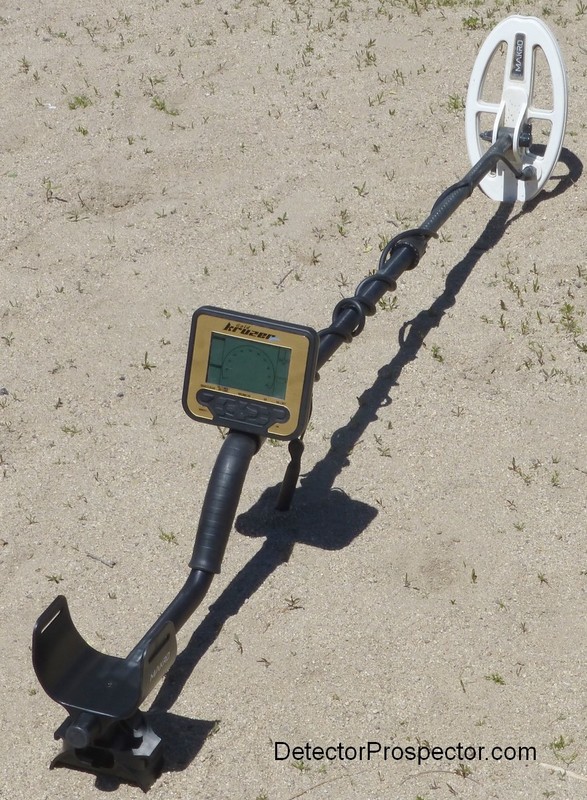
Makro Gold Kruzer with optional 5” x 9.5” DD coil
There are many features I could delve into but at over six pages this report is getting long, so I will again refer people to the User Manual for the details. Suffice it to say that the Makro Gold Kruzer has a full set of features like frequency shift for reducing interference, temporary audio boost for the Gen all metal mode, adjustable backlight, and the ability to save settings when the detector is powered down, and more.
I got the Gold Kruzer prototype during a period when I was quite busy and the weather was not helping. I did have time to do a few tot lot hunts plus make a trip to the goldfields to evaluate the machine. The Gold Kruzer is well behaved in urban locations, with only a little static from electrical interference sources. I found the new Micro mode to be just the ticket for quickly blasting through a tot lot recovering prime gold range targets. I dug everything as is my practice when learning a detector, and ended up with the usual pile of aluminum foil, junk jewelry, and coins. Nothing special found but no doubt in my mind that the Gold Kruzer acts as intended in this type of setting.
There were no surprises in the goldfields. At 61 kHz and in Gen mode the Gold Kruzer is a real pleasure to run, with all the response and nuance one expects from a great threshold based all metal circuit. Boost Mode also works very well as an alternative for small nugget detecting. I had no problem at all finding a couple little bits of gold weighing under a grain (480 grains per Troy ounce) on my first and only nugget hunt so far with the Gold Kruzer.
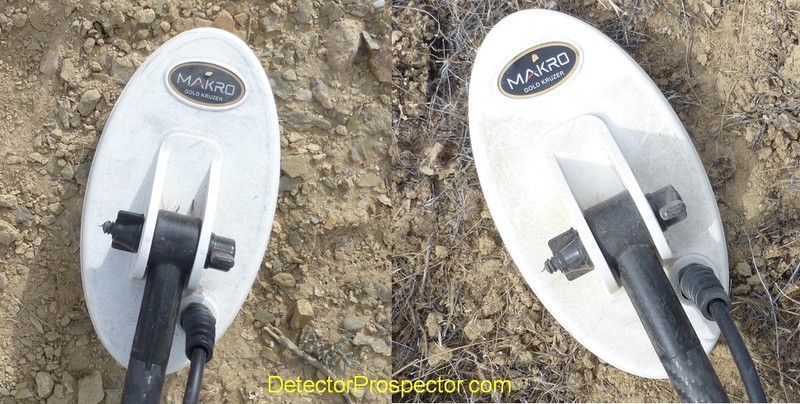
Two tiny gold nuggets found with Makro Gold Kruzer
To sum up, the new Makro Gold Kruzer once again ups the ante at Makro. It comes standard with two coils and is fully waterproof for about the same price as the Makro Gold Racer so I would have to assume the Gold Racers days are numbered. The one thing I am not sure about at this time is that the Gold Racer has a 15” x 13” DD coil option. The Makro Multi Kruzer has the 15” coil option, but no such accessory has yet been announced for the Gold Kruzer. This is probably not a concern for very many people, but it bears mentioning. May 2019 Note: The Makro Gold Racer is still in production but the price was lowered to $509. Nokta/Makro have also produced a 15.5" x 13" coil option for the Gold Kruzer.
I have no problem at all recommending that anyone interested in a detector with a focus on gold take a very serious look at the new Makro Gold Kruzer. It’s performance on low conductors of any type means that the Gold Kruzer is not just for prospectors and jewelry hunters but may also see favor with some relic hunters who focus of low conductor targets like buttons and bullets. This is a solid detector with 21st century features at a very attractive price.
~ Steve Herschbach
Copyright © 2018 Herschbach Enterprises
-
 6
6
-
 1
1


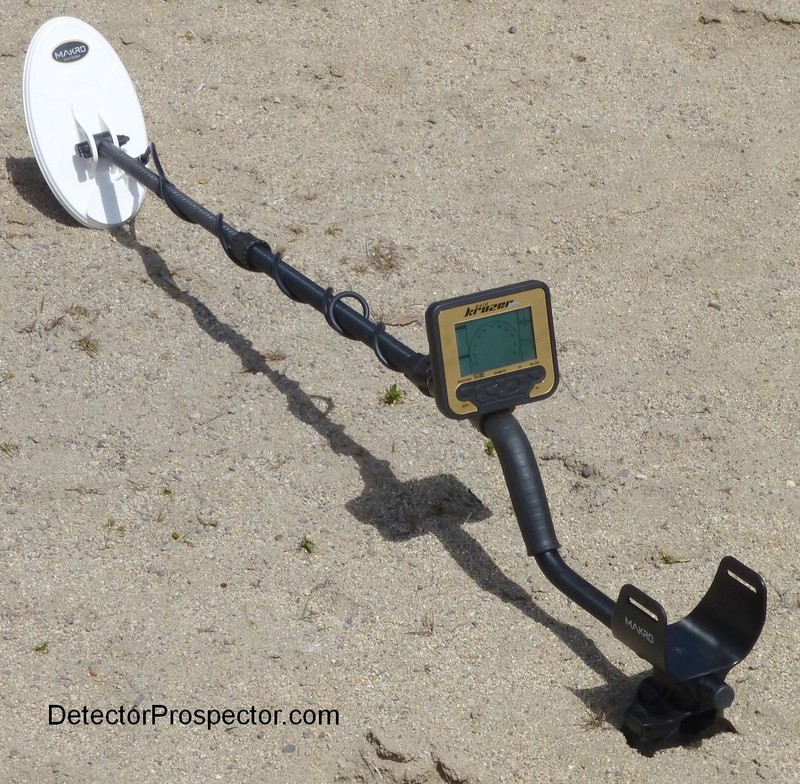
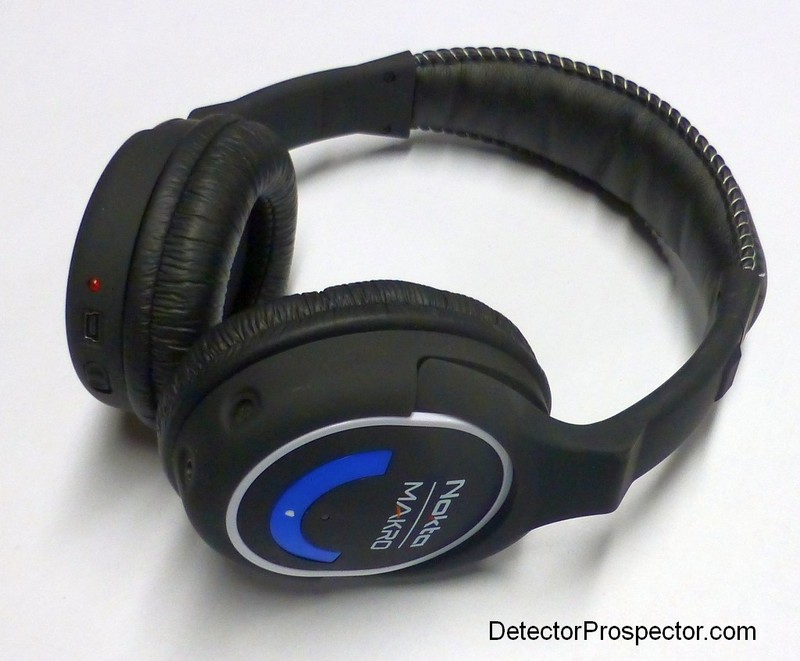

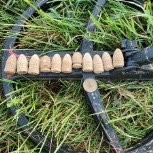



.thumb.jpg.ac5e8ee36e43bcab745dbc623fcf1874.jpg)
